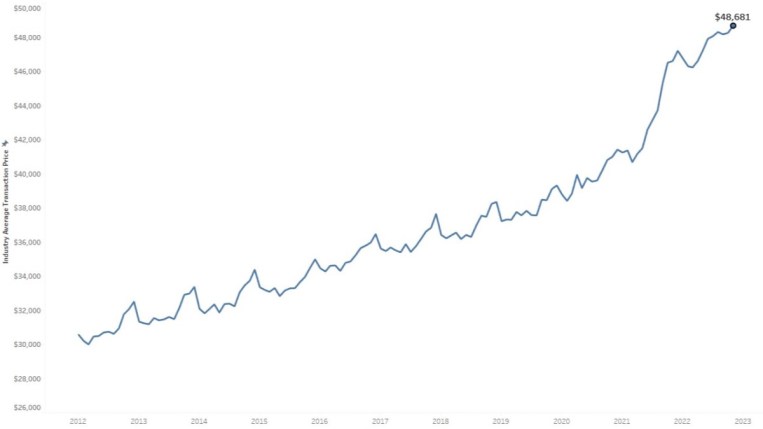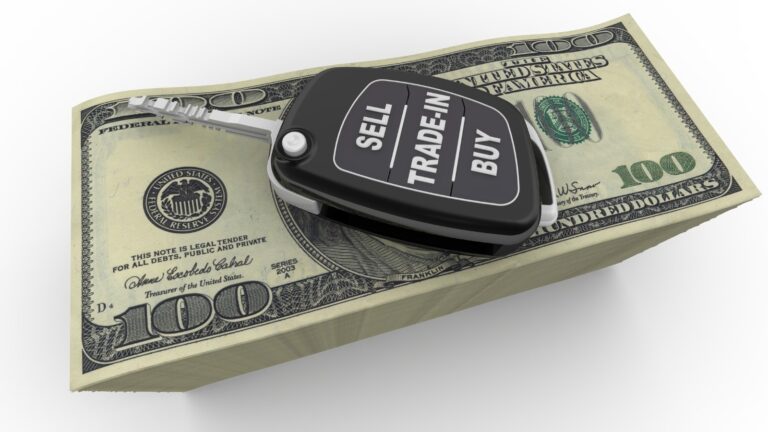Car shoppers have grown used to relentless bad news, but recent developments mean some can breathe a little easier. Others, we’re sorry to say, will only see conditions worsen.
The difference? Whether you’re shopping for a new car or a used one.
New car prices are on the rise, breaking records monthly. Used car prices are starting to fall, and our experts tell us that both of those trends could be with us well into 2023.
The average new car price set an all-time record in November, selling for $48,681. We expect prices to continue to rise for the next several months.
Used car prices, meanwhile, are on a steady downward trend. The average used car sold for $27,156 in November — $408 less than a month before. Signs suggest that further price drops are ahead.
That doesn’t make the story simple. Most car shoppers remain effectively in both markets at once, with a car to swap. But recent trends have created an unpredictable market predictable for a few months.
Does that mean it’s time to shop for a new or used car? How does it compute when selling or trading in your vehicle? Read on.
What New Car Shoppers Can Expect

The average new vehicle sold for $48,681 in November, according to Kelley Blue Book parent company Cox Automotive. That’s an all-time high. But it’s a record that may not stand for long.
RELATED: When Will New Car Prices Drop?
Two factors are combining to create a cycle pushing new car prices higher.
A global shortage of microchips has left automakers unable to produce cars fast enough.
Meanwhile, the Federal Reserve has raised interest rates more in the last year than in any other calendar year in history.
The Fed’s moves are tightening access to credit in an attempt to slow Americans shopping for big-ticket items and bring inflation under control. The tactic may work in other industries but it’s not bringing down new vehicle prices because of the new car inventory shortage. It’s actually pushing them up.
Automakers are looking at the landscape and realizing that only high-income, good-credit consumers can afford new cars at these high-interest rates. Since the microchip crisis limits the number of new cars they can build, they’re mostly building expensive cars for those buyers.
The situation is different at every sales lot. Some brands have more supply than others.
In the luxury market, Porsche and Land Rover sold cars for an average of between 2% and 6.4% over sticker in November. But Alfa Romeo, Audi, BMW, Infiniti, Lincoln, and Volvo all sold for 1% or more below the manufacturer’s suggested retail price, or MSRP.
Among non-luxury brands, Honda and Kia dealerships were the hardest places to find a bargain. They sold the average car for 6% to 8% over sticker in November. Meanwhile, Buick showed the least price strength, selling 2% or more below MSRP.
What Used Car Shoppers Can Expect
For used car shoppers, the news is much better. Prices stabilized in September. Then they fell in October. They fell again in November.
They’ll likely keep falling. The wholesale prices dealers pay for the used cars they later sell have fallen more than 14% over the last year. When wholesale prices fall, retail prices follow.
It’s still hard to find the least-expensive used cars. Dealers have a limited supply of the higher-mileage cars they sell for less than $10,000. But used car prices are falling and will likely continue to fall for the next few months.
Will Supply Chain Problems End Soon?
You may see headlines suggesting that the microchip supply problem looks to be easing. While true for the computer and smartphone industries, it’s taking longer to catch up on the supply of the kind of chips automakers need.
Still, once it eases, the new car inventory may not return to normal. COVID-19-related lockdowns in Asia earlier this year slowed the production of cars, and European automakers face parts supply problems caused by the ongoing war in Ukraine.
Automakers and dealer groups have also learned that keeping the supply of cars low allows them to charge more for the cars they do build. The days of dealer stockpiles and hefty discounts may not return.
Pre-pandemic, Americans routinely bought more than 17 million new cars per year. In 2021, we bought just over 15 million. Cox Automotive recently trimmed its forecast for 2022. It now predicts Americans will buy just 13.7 million this year.
RELATED: Ordering a Car From the Factory – Everything You Need to Know
Fed Interest Rate Hikes Could Make the Situation Worse
The Fed has been blunt about its aims — it knows that its interest rate increases will increase unemployment. Fed leaders see that as the only way to reel in spiraling inflation.
But Cox Automotive Chief Economist Jonathan Smoke says it won’t stop the inflation of new car prices anytime soon.
“A weak economy with job losses is not good for vehicle demand. Payment affordability will be much more of an acute challenge in 2023 than what has been experienced over the last two decades,” he explains.
With payments so high — the average new car buyer in November signed up for a monthly payment of $762 — automakers know they must target wealthier buyers. That leaves them building few affordable cars.
That is “reducing demand and tilting the new market to further favor wealthy consumers.” More than 18% of the new cars Americans bought last month were luxury cars — a near-record.
The used car market, Smoke says, sees better news. “The only hope for relief in the near term will be in the used market, where used-retail prices are finally starting to decline at an accelerating pace,” he says.
He expects used car prices to decline “for much of the next year.”
Older, Less Expensive Cars Harder To Find
If you hope to find an older vehicle and your budget is less than $15,000, these vehicles remain in short supply. More would-be new car shoppers started buying up the available used cars. So, the shortage of lower-priced cars is partly due to a lack of inventory.
Americans are holding onto their cars longer than ever. The average car on American roads is now 12.2 years old. Automakers also produced fewer cars for several years after the 2008 recession. That leaves fewer higher-mileage, older used vehicles available to sell.
The easiest used cars to find are priced between $15,000 and $30,000. Cars priced under $15,000 remain few and far between.
How To Buy a Car Right Now

If you want to purchase a new or used vehicle, be prepared for sticker shock.
But take stock of some good news that your next car will likely last a long time and help you drive safer than ever with all the technological advances and offerings.
RELATED: Buying Older, Used Cars in 2022
Vehicle quality studies repeatedly show that today’s new cars suffer fewer problems than those from just a few years before. That means that any buyers of higher-priced used cars will likely see the vehicle driving on the road even longer. The same goes for those buying new ones.
With most automakers now building such durable cars, they compete by adding more and more high-tech features. Features like adaptive cruise control and Apple CarPlay are now more common than ever on entry-level vehicles.
Read on to see our tips on buying a car below.
RELATED: How to Buy a New Car in 10 Steps
Selling a Car Right Now
Few of us are in the position of selling a car without needing to buy a replacement for it. But, if that’s you, what are you waiting for? Used car prices began falling from record highs. Moreover, you will get more for your car today than you will tomorrow.
The best way to get the most money for your used car is to sell it privately. But if you don’t want the hassle, there is still an opportunity to sell to a dealership.
Trading In a Car Now
The combination of soaring new car prices and falling used car prices could be a worst-case scenario for your trade-in. However, it’s still possible to get a better price for your trade-in by shopping it around.
Each dealership tries to keep a balance of vehicles on its lot. Sometimes, the one you want to buy from doesn’t need your trade-in desperately, but a competitor does.
Research the Kelley Blue Book value of your vehicle, then call several local dealerships to see what they’ll offer you for it. Or try our Instant Cash Offer tool, which brings the deal to you from various dealerships without obligation. You can choose the offer you prefer or use it to negotiate with others.
Looking Ahead
Falling used car prices make it a good time to buy used. Rising new car prices make it a challenging time to buy new.
Typically, we’d advise used car shoppers to move now and new car shoppers to wait for a better market. However, prices may never return to a pre-pandemic “normal.” Several automakers have said they plan to keep inventories lower indefinitely, maintaining high prices.
Our best advice for new car buyers is still to wait if possible. Used car shoppers, however, can begin to venture out, confident of finding a reasonable selection.
RELATED: 10 Best Car Deals
Tips for Buying a Vehicle Right Now
If you must shop right now, we recommend a few strategies to help you find the right new or used car that fits your budget.
- Expand your search. Widen your search to a broader geographic area.
- Stay patient. Call dealerships early and often to see what’s coming off the trucks. Leave a refundable deposit if you want first dibs.
- Understand the timing. Be prepared to shop for several weeks, and know it involves calling or visiting dozens of dealerships as you look for the right fit.
- Don’t jump. Shop around your trade-in as aggressively as you seek out the right car. Don’t accept the first offer. You could sell yourself short in such a good market.
It may still make sense to keep your existing car for another year if you can. If you must buy, be prepared to take excellent care of your next car to keep it running for a long time.
Related Articles About Car Buying and Selling:
This article has been updated since it was originally published.


